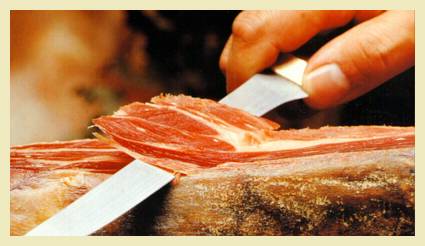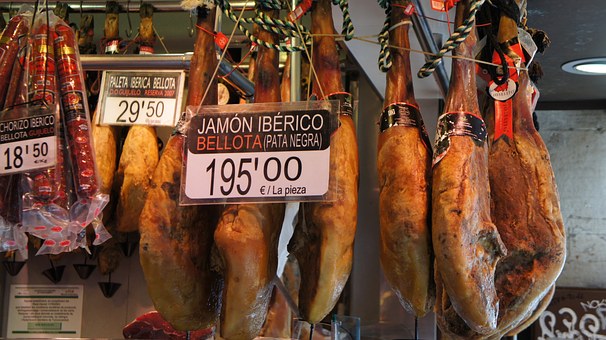

Spanish Cured Ham Web Page is
designed to provide a reference point for one of Spain's best
tasting, but lesser known agricultural products: Cured "Serrano" Ham. Produced
using methods similar to those employed in Italy for making "Parma ham",
or in France to produce "jambon cru"; the Spanish variety offers a unique
taste experience, with its own special flavor, texture and aroma.
These hams are a key component in Spanish cuisine, and recent changes
in import legislation have begun to make them available in the US, Europe and other
parts of the world. Served in thin slices, it makes an exquisite snack;
and small amounts add a delightful flavor to a wide variety of dishes such
as soups, vegetables, or pasta. Such is the variety and complexity in flavor,
aroma and texture, that experts regularly organize tastings in much the
same way as with wine.
As it does for wine and other agricultural products, The Instituto Nacional de Denominaciones de Origin (INDO), maintains the "Denominación de Origin" (DO) program for cured ham. The DO is in fact quality control program, designed to insure the both the origin of the product, as well as it's production methods, raw materials, etc.

Serrano means "from the mountains", as the cool dry mountain air offers the perfect conditions for the curing process. The process in fact involves three distinct phases:
1. The fresh hams are first trimmed and cleaned, then stacked like cordwood and covered with salt. This serves to draw off excess moisture and to preserve the meat from spoiling. This typically lasts 2 weeks.
2. The salt is washed off and the hams hung to dry and start the first curing phase. This phase serves to initiate the curing process, here (among other things) the fat begins to breakdown. This takes about 6 months.
3. Air drying - it is during this phase that the hams are hung in a cool, dry place, and where the distinct, subtle flavors and aromas develop. This lasts from 6 to 18 months, depending on the climate, as well as the size and type of ham being cured. The drying sheds ("secaderos") are usually built at higher elevations, thus the name "serrano".
There are three main factors that determine the quality - and of course
the price - of the serrano hams:
Cut
Type of Hog
Feeding Conditions
There are two distinct cuts: the hind leg or "jamón" (ham), and the foreleg or "paleta" (shoulder). As we'll see a bit further on, there are also two different classes of hog grown for ham production: the native Iberian hog which makes for the highest quality, but only represents about 5% of the total production, and the more cost-effective "white hog" - normally of the Large White, Landrace, or Duroc strains and crosses.
Feeding conditions are an important factor in both production and quality. The best hams are produced from the long legged Iberian hogs, range fed and fattened on acorns in the cork-oak groves along the southern half of the border between Spain and Portugal. While range fed, Iberian hogs produce without a doubt the "creme de la creme" of Spanish hams, this method is costly, slow and not particularly productive. Thus, the large majority of hams in the marketplace are derived from "white hogs".